|
Philadelphia Memories (Part IV)
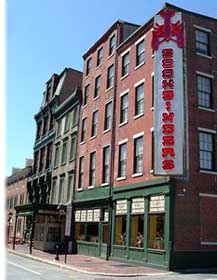 Another Icon Gone: Goodbye to Philadelphia's Old Original Bookbinder's, the legendary 116 year-old Society Hill restaurant. Word is that the latest generation of owners ran the joint into the ground. Another Icon Gone: Goodbye to Philadelphia's Old Original Bookbinder's, the legendary 116 year-old Society Hill restaurant. Word is that the latest generation of owners ran the joint into the ground.
Beginning as a lowly oyster bar, Bookbinder's moved to Second and Walnut Streets in 1898 to be closer to the Delaware River docks. And began its ascent to eventually emerge as one of Philly's best-known dining establishments.
Whenever out of town business travelers came to Philly, they requested dinner at the well-known city landmark, to see the bas-reliefs of long-gone U.S. presidents on its stained-glass facade and the Gettysburg Address written in bronze near the front door. As well as the fireplace made from cobblestones which were claimed to have come from "the original Walnut St. cobblestones over which George Washington and his troops marched on their way to Valley Forge." The fireplace was flanked by two old "Revolutionary cannons" - at least, that's what the Bookbinder's souvenir postcard caption proclaimed.
I spent many an evening entertaining corporate clients at Bookies, as we used to call it. It was an expense account place, overpriced and dependent on business, tourist and special occasion clients. But the food was decent enough and sometimes you'd get a glimpse of the famous and influential dining at a nearby table.
There was another one: Bookbinder's Seafood House. Two of founder Samuel Bookbinder's grandsons opened it in 1935 on 15th Street near Locust in center city. Over the years, the two restaurants regularly feuded over the name. The 15th Street restaurant closed in 2004; the location is now an Applebee's - a fate even worse than death. (posted 5/8/09, permalink)
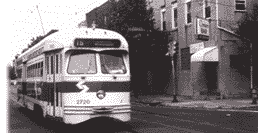 What's In A Name? The photo book 'Southeastern Pennsylvania Trolleys' by Kenneth Springirth has a variety of Philadelphia neighborhood photos. At the end of a block of row homes, there is often a business establishment - a corner grocery, a dentist, a bakery or a tavern. What's In A Name? The photo book 'Southeastern Pennsylvania Trolleys' by Kenneth Springirth has a variety of Philadelphia neighborhood photos. At the end of a block of row homes, there is often a business establishment - a corner grocery, a dentist, a bakery or a tavern.
When I saw this photo at the corner of Richmond and Clearfield Sts. in the Kensington section of Philly, I could tell that there was a bar on the corner. But I couldn't read the sign.
So I got a magnifying glass to see what kind of clever name it had. I was expecting something like The Tipsy Top, Stumble Inn, Crossing The Bar, Come Back Inn, Ye Olde Ale House, etc. This is what I found:
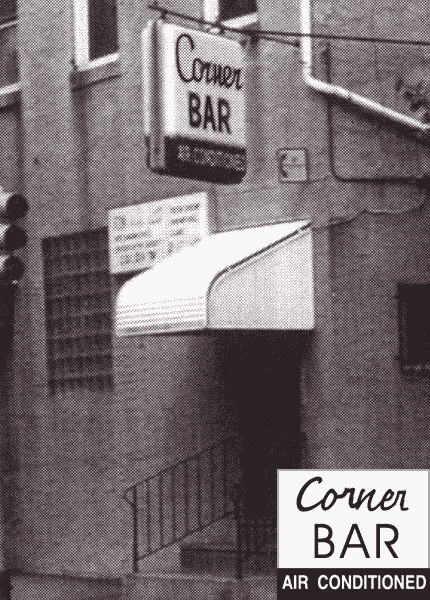
I guess the owner didn't have much imagination. (posted 1/9/09, permalink)
The Good Old Days ... they were awful. This news item, which appeared on March 14, 1904 in the Philadelphia Inquirer, is just one example:
No, she's not a relative that I know of, even though I once lived in Frankford. (posted 3/13/09, permalink)
When Billy Penn Was Black: People today whine and complain about pollution but the so-called Good Old Days had a lot more of it.
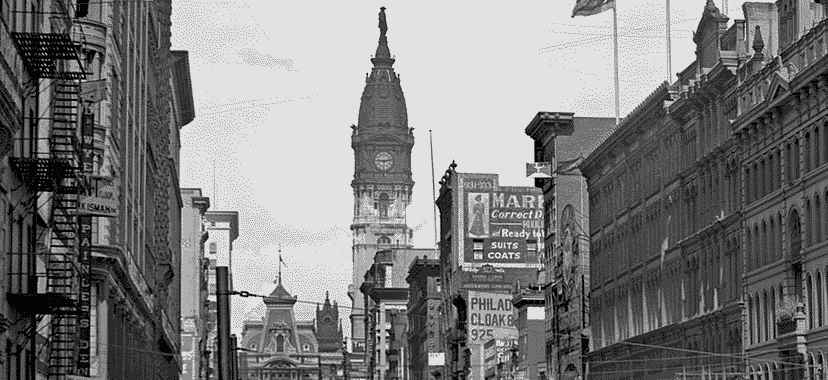
In 1905, there was so much soot and coal dust in Philadelphia's air, that the 11 year-old statue of William Penn atop City Hall had turned black with soot. The smoke came from hundreds of nearby coal-heated buildings and thousands of puffing, coal-fired locomotives visiting Broad Street Station, only a couple of blocks away. The Pennsylvania Railroad eventually electrified the urban station but no electric locomotives operated out of Broad Street until 1915 or so.
Philadelphia's City Hall, topped by Penn's statue, was the tallest habitable building in the world from 1901 to 1908 and the tallest in Pennsylvania until 1932. It remained the tallest building in Philadelphia until the 1980s. During that period, Billy Penn's statue dominated the Philly skyline.
William Penn founded Philadelphia in 1682. He was known as an early champion of democracy and religious freedom. As a pacifist Quaker, Penn considered the problems of war and peace deeply, and included a plan for a United States of Europe in his voluminous writings.
Billy's statue stands thirty-seven feet tall, and weighs twenty-seven tons. He is the tallest sculpture on top of any building in the world. His five-foot long hand is pointing northeast towards Penn Treaty Park, where Penn made a treaty of friendship with Native Americans in 1682. The hand appears to be making a gesture of blessing and welcome. The bronze statue has magnificent details including decorated buttons and lace cuffs. Penn carries the Charter of Pennsylvania from King Charles II, which has legible words written on it. This statue was one of 250 sculptures created by Alexander Milne Calder that adorn the building inside and out.
Penn's statue is hollow, and a narrow access tunnel through it leads to a small, 22-inch diameter hatch atop the hat. (Public access ends at an observation deck just below the statue.) At 37 feet tall, is the largest single piece of sculpture on any building in the world. The statue was installed on the tower in late 1894, after being displayed in the city hall courtyard a year.
The mammoth was statue constructed in 14 pieces. It is the largest sculpture ever to be cast in bronze and was originally hoisted in sections by sixteen workmen to its place atop City Hall tower 548 feet above street level. The casting and fabrication was done by Tacony Iron & Metal (est. 1881) of State Road in Northeast Philadelphia.
In a 1939 newspaper interview, a Mrs. Tomlinson recalled, "My husband's favorite story was that he drove the team that hauled the statue's parts downtown. He often told how, one rainy day, Billy Penn's hand, extending out over the driver's seat, protected him from the rain." It required teams of sixteen horses to haul single pieces of the statue downtown.
Tacony Iron & Metal Company went out of business by 1910.
The statue and the building were treated to a six-year restoration and upgrading project beginning in the 1980s. (posted 2/11/09, permalink)
Bye Bye Olga's: One of South Jersey's most recognized landmarks, Olga's Diner, has closed for good. The iconic Marlton Circle eatery, where Routes 70 and 73 meet, has been closed since October. Owner John Stavros, 77, has finally said he won't reopen and is selling the property.
The reason, in part, is its location. It's been subject to on-again, off-again plans for highway redevelopment since the 1990s. The 77-year-old said his three children have no interest in continuing the family business, and he doesn't have the energy to save it. The diner, named after Stavros' Greek mother, Olga, opened in Camden in 1946 before moving to the present site in 1959.

I've eaten there many times over the years - with my parents, friends, dates and - later - with my family and always enjoyed it. Now the eight-foot red sign, the popular bakery and the delightful diner fare - all of which attracted generations of commuters, teenagers and Philly travelers headed to the Shore - is just a memory. (posted 12/15/08, permalink)
Ice Cream Story: Just before Thanksgiving 2008, we had friends over to see my Philly-themed train layout. Like us, they grew up in Philadelphia. Looking at the layout, they asked, "Where's the Breyers sign?" The company's ice cream signs were everywhere in Philly. I think almost every little corner store and luncheonette had one hung outside its building.
So I ordered an animated neon Breyers sign from Miller Engineering. It arrived last week. I installed it on the roof of a generic building - which could easily pass for a luncheonette because it has a little table and chairs on the partly screened patio - on the HO-scale mountain layout.
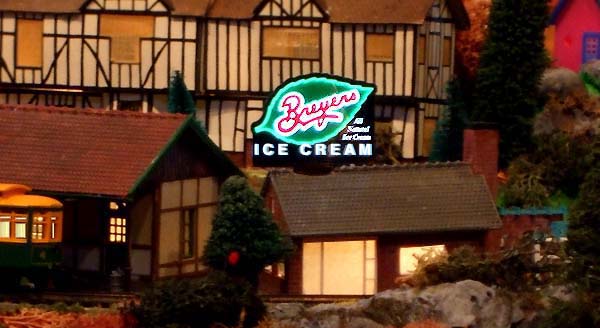
This structure was glued together 37 or so years ago by me and its joints began to separate as I drilled pilot holes for the slot on the roof crest. I repaired them with epoxy and reglued some other loose pieces with styrene cement. Good as new. I made the slot with my Dremel tool, using various attachments. I also cut a slot in the plywood base of the mountain to accommodate the rectangular wire set.
The Breyers sign is appropriate for my train layout because the company is truly a Philadelphia institution. In 1866, William A. Breyer started hand-cranking ice cream in his kitchen and selling it to neighbors. He lived in the Kensington section of Philly.
Breyer opened his first retail ice cream shop in 1882. Within a short time he and his family opened four more retail shops. In 1896, the company opened its first manufacturing plant. By 1918, Breyers Ice Cream Company was producing more than a million gallons of ice cream a year and shipping it to New York City, Staten Island, Newark, NJ and Washington, D.C.
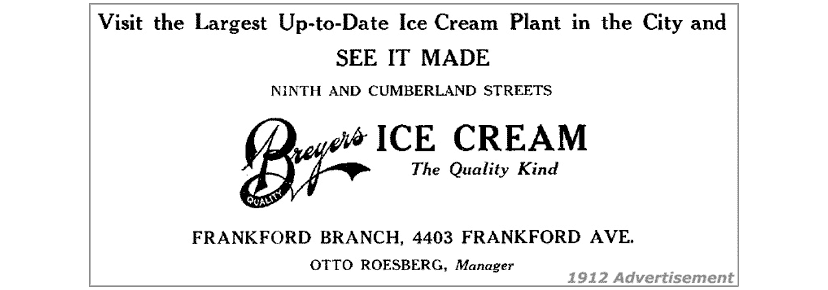
The vast majority of small corner stores in Philadelphia had large Breyers ice cream signs, featuring the firm's trademark green leaf, hanging outside. While there were local and regional competitors offering their own signage to small stores (Dolly Madison, Sealtest, Bassett's, Borden - with its signature Elsie the Cow), Breyers had the dominant share of stores - at least in Northeast Philadelphia where I lived.
In 1984, Breyers headed toward national recognition by selling its product west of the Mississippi River for the first time. We can now buy it locally in the Pacific Northwest. (posted 12/10/08, permalink)
Philly Re-Creation: Every year, during the Christmas season, we put up my O-gauge (Lionel-size) train layout which brings a little bit of old Philadelphia to the Pacific Northwest. There are Pennsylvania Railroad trains, PTC trolleys and buses, the Mayfair Diner and even the Tastykake factory. (posted 12/1/08, permalink)
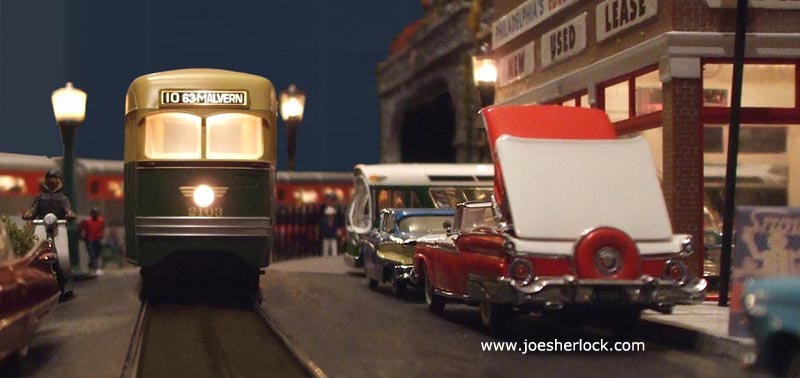
Remembering Hanscom's: Last week, I placed our Swiss Colony order for Christmas. Among other things, I ordered a two-pound Dobosh torte - the closest thing I've been able to find to Hanscom's seven-layer cake (a childhood favorite). People who grew up in Philadelphia knew all about the Hanscom Bakery and its wonderful offerings.
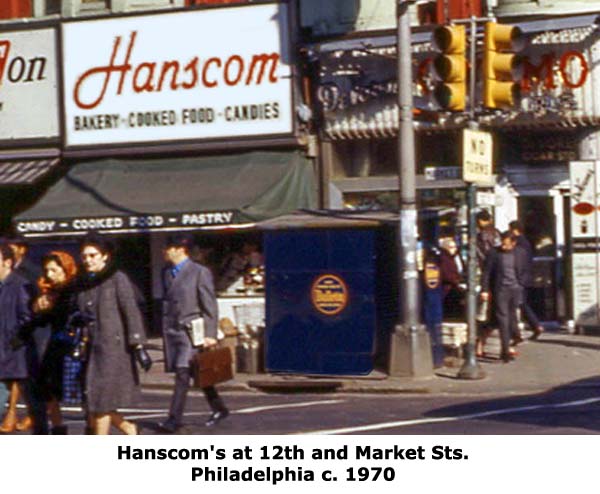
One of my uncles was once the firm's head baker. Hanscom's Bakery went bankrupt in 1984 after 101 years in business. Hanscom's also made tea biscuits which were a frequent sight around our house when company was coming. I also enjoyed Hanscom's Vienna Bread. And its sticky buns. (posted 11/28/08, permalink)
Trip Report: In October 2008, we took a whirlwind tour of Pennsylvania and New Jersey, including an extended stay in the Philadelphia area ... (more >>>)
 Going ... Going ... Gone: For 12 years, I worked for Rohm & Haas Co. - the large, Philadelphia-headquartered specialty chemicals and plastics manufacturer - in various positions, starting as an laboratory engineer and ending as a product/marketing manager. Going ... Going ... Gone: For 12 years, I worked for Rohm & Haas Co. - the large, Philadelphia-headquartered specialty chemicals and plastics manufacturer - in various positions, starting as an laboratory engineer and ending as a product/marketing manager.
It was my longest corporate stint and my last one. I left R&H to start my own plastics business. And never worked for anyone else again.
Dow Chemical has announced that they are buying Rohm & Haas. Dow is paying $15.3 billion in cash for the Philadelphia-based specialty chemicals company. There's a lot more to this and it gave me a couple of The Simpsons moments ... (more >>>)
copyright 2008-21 - Joseph M. Sherlock - All applicable rights reserved
Disclaimer
The facts presented on this website are based on my best guesses and my substantially faulty geezer memory. The opinions expressed herein are strictly those of the author and are protected by the U.S. Constitution. Probably.
Spelling, punctuation and syntax errors are cheerfully repaired when I find them; grudgingly fixed when you do.
If I have slandered any brands of automobiles, either expressly or inadvertently, they're most likely crap cars and deserve it. Automobile manufacturers should be aware that they always have the option of trying to change my mind by providing me with vehicles to test drive.
If I have slandered any people or corporations, either expressly or inadvertently, they should buy me strong drinks (and an expensive meal) and try to prove to me that they're not the jerks I've portrayed them to be. If you're buying, I'm willing to listen.
Don't be shy - try a bribe. It might help.
|